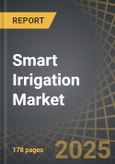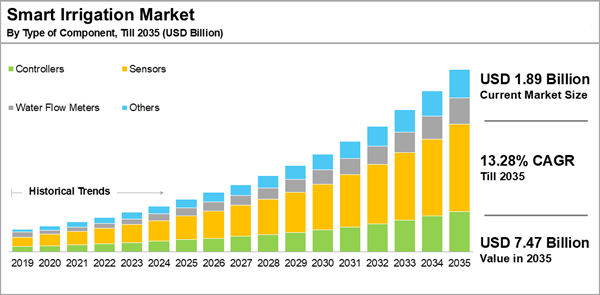The global smart irrigation market size is estimated to grow from USD 1.89 billion in 2025, to USD 7.47 billion by 2035, at a CAGR of 13.28% during the forecast period, till 2035.
Smart Irrigation Market: Growth and Trends
According to the Food and Agriculture Organization, over 305 million hectares worldwide are currently set up for irrigation. This demonstrates the groundbreaking integration of technology into irrigation. It is important to note that artificial intelligence in irrigation is set to transform the industry as smart technologies are increasingly incorporated into various agricultural practices to enhance crop management and resource use.
Some key benefits of smart irrigation include water and energy savings, reduced labor costs, improved plant health, and substantial long-term cost reductions. Additionally, smart irrigation provides various features, such as weather-responsive and soil moisture monitoring technologies that adjust watering schedules in real-time, remote access via mobile devices, and data analytics for continuous optimization. It is essential to recognize that the adoption of technological innovations like AI and IoT in major industries is increasing due to the rapid expansion of the internet and growing public awareness.
The smart irrigation market is rising as an essential element in the global evolution towards innovation and digital change aimed at achieving greater farming efficiency and water conservation. Internet of Things (IoT) devices have been crucial in realizing the full potential of the smart irrigation market by utilizing sensors to gather real-time information on soil moisture, weather patterns, and crop conditions. Further, AI-powered tools facilitate precise predictive modeling and adaptable irrigation strategies by analyzing data, thereby improving both efficiency and sustainability in water management.
As a result, with ongoing technological advancements and increasing investment, the smart irrigation market is anticipated to grow significantly during the forecast period.
Report Scope
Type of Component
- Controllers
- Sensors
- Water Flow Meters
- Others
Type of System
- Sensor-Based Controller Systems
- Weather-Based Controller Systems
Area of Application
- Agricultural
- Non-Agricultural
Type of Enterprise
- Large
- Small and Medium Enterprise
Geographical Regions
- North America
- US
- Canada
- Mexico
- Other North American countries
- Europe
- Austria
- Belgium
- Denmark
- France
- Germany
- Ireland
- Italy
- Netherlands
- Norway
- Russia
- Spain
- Sweden
- Switzerland
- UK
- Other European countries
- Asia
- China
- India
- Japan
- Singapore
- South Korea
- Other Asian countries
- Latin America
- Brazil
- Chile
- Colombia
- Venezuela
- Other Latin American countries
- Middle East and North Africa
- Egypt
- Iran
- Iraq
- Israel
- Kuwait
- Saudi Arabia
- UAE
- Other MENA countries
- Rest of the World
- Australia
- New Zealand
- Other countries
Smart Irrigation Market: Key Segments
Market Share by Type of Component
Based on type of component, the global smart irrigation market is segmented into controllers, sensors, water flow meters and others. According to estimates, currently, sensors capture the majority share of the market. Further, this segment is expected to grow at a higher CAGR during the forecast period. This can be attributed to several factors, including their essential function in improving agricultural output and resource utilization by offering real-time information on soil moisture, temperature, and humidity.
Market Share by Type of System
Based on type of system, the smart irrigation market is segmented into sensor-based controller systems and weather-based controller systems. According to estimates, currently, sensor-based controller systems capture the majority of the market. Further, this segment is expected to grow at a higher CAGR during the forecast period. This can be attributed to its capability to examine extensive datasets from various sources, along with its enhanced efficiency and flexibility in comparison to irrigation control systems that rely on weather data.
Market Share by Area of Application
Based on area of application, the smart irrigation market is segmented into agricultural and non-agricultural. According to estimates, currently, non-agricultural segment captures the majority share of the market. This can be attributed to the growing need for effective water management in landscaping, golf courses, and sports venues, especially in urban locations experiencing water shortages.
Market Share by Type of Enterprise
Based on type of enterprise, the smart irrigation market is segmented into large and small and medium enterprise. According to our estimates, currently, large companies capture the majority share of the market. Further, this segment is expected to grow at a higher CAGR during the forecast period. This can be attributed to its ability to invest in advanced irrigation technologies, leverage significant resources, enhance economies of scale, and promote business expansion.
Market Share by Geographical Regions
Based on geographical regions, the smart irrigation market is segmented into North America, Europe, Asia, Latin America, Middle East and North Africa, and the rest of the world. According to estimates, currently, North America captures the majority share of the market. However, owing to the significant investments, government programs, and the expanding irrigation sector in nations such as China and India, the market in Asia is anticipated to grow at a relatively higher CAGR during the forecast period.
Sample Players in Smart Irrigation Market Profiled in the Report Include
- AquaSpy
- Banyan Water
- Caipos
- Calsense
- Delta-T Devices
- ET Water
- Galcon
- Hunter Industries
- HydroPoint
- Jain Irrigation
- Netafim
- Rachio
- Rain Bird
- Soil Scout Oy
- The Toro Company
- Weathermatic
Smart Irrigation Market: Research Coverage
The report on the smart irrigation market features insights on various sections, including:
- Market Sizing and Opportunity Analysis: An in-depth analysis of the smart irrigation market, focusing on key market segments, including [A] type of component, [B] type of system, [C] area of application, [D] type of enterprise, [E] geographical regions.
- Competitive Landscape: A comprehensive analysis of the companies engaged in the smart irrigation market, based on several relevant parameters, such as [A] year of establishment, [B] company size, [C] location of headquarters and [D] type of component, [E] type of system, [F] area of application, [G] type of enterprise
- Company Profiles: Elaborate profiles of prominent players engaged in the smart irrigation market, providing details on [A] location of headquarters, [B]company size, [C] company mission, [D] company footprint, [E] management team, [F] contact details, [G] financial information, [H] operating business segments, [I] smart irrigation portfolio, [J] moat analysis, [K] recent developments, and an informed future outlook.
- Megatrends: An evaluation of ongoing megatrends in smart irrigation industry.
- Patent Analysis: An insightful analysis of patents filed / granted in the smart irrigation domain, based on relevant parameters, including [A] type of patent, [B] patent publication year, [C] patent age and [D] leading players.
- Recent Developments: An overview of the recent developments made in the smart irrigation market, along with analysis based on relevant parameters, including [A] year of initiative, [B] type of initiative, [C] geographical distribution and [D] most active players.
- Porter’s Five Forces Analysis: An analysis of five competitive forces prevailing in the smart irrigation market, including threats of new entrants, bargaining power of buyers, bargaining power of suppliers, threats of substitute products and rivalry among existing competitors.
- SWOT Analysis: An insightful SWOT framework, highlighting the strengths, weaknesses, opportunities and threats in the domain. Additionally, it provides Harvey ball analysis, highlighting the relative impact of each SWOT parameter.
Key Questions Answered in this Report
- How many companies are currently engaged in smart irrigation market?
- Which are the leading companies in this market?
- What factors are likely to influence the evolution of this market?
- What is the current and future market size?
- What is the CAGR of this market?
- How is the current and future market opportunity likely to be distributed across key market segments?
Reasons to Buy this Report
- The report provides a comprehensive market analysis, offering detailed revenue projections of the overall market and its specific sub-segments. This information is valuable to both established market leaders and emerging entrants.
- Stakeholders can leverage the report to gain a deeper understanding of the competitive dynamics within the market. By analyzing the competitive landscape, businesses can make informed decisions to optimize their market positioning and develop effective go-to-market strategies.
- The report offers stakeholders a comprehensive overview of the market, including key drivers, barriers, opportunities, and challenges. This information empowers stakeholders to stay abreast of market trends and make data-driven decisions to capitalize on growth prospects.
Additional Benefits
- Complimentary Excel Data Packs for all Analytical Modules in the Report
- 15% Free Content Customization
- Detailed Report Walkthrough Session with Research Team
- Free Updated report if the report is 6-12 months old or older
This product will be updated with the latest data at the time of order. Consequently, dispatch time for this product will be 7-10 business days.
Table of Contents
SECTION I: REPORT OVERVIEW
Companies Mentioned (Partial List)
A selection of companies mentioned in this report includes, but is not limited to:
- AquaSpy
- Banyan Water
- Caipos
- Calsense
- Delta-T Devices
- ET Water
- Galcon
- Hunter Industries
- HydroPoint
- Jain Irrigation
- Netafim
- Rachio
- Rain Bird
- Soil Scout Oy
- The Toro Company
- Weathermatic
Methodology

LOADING...









